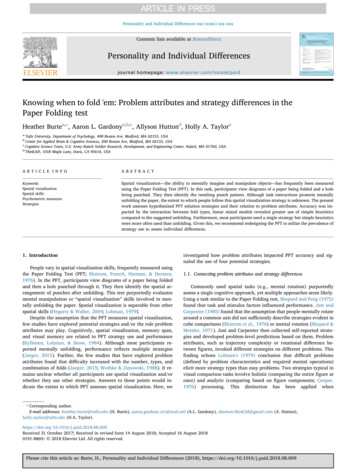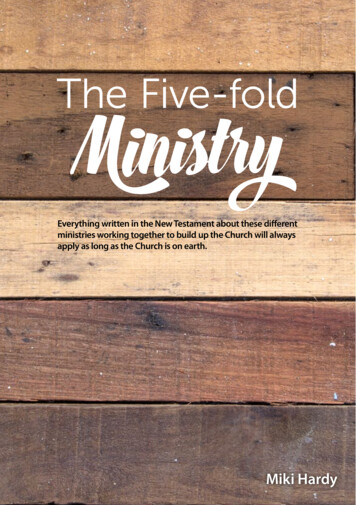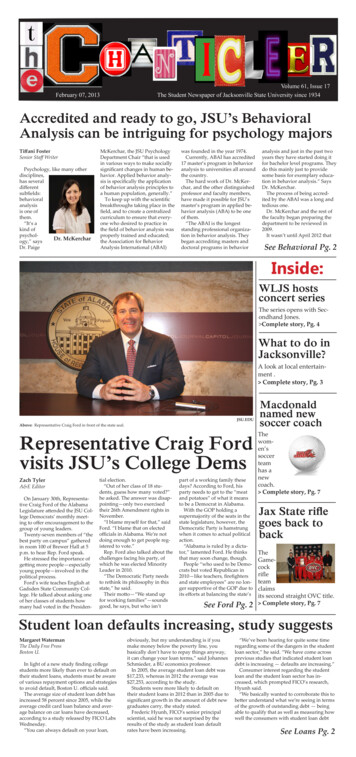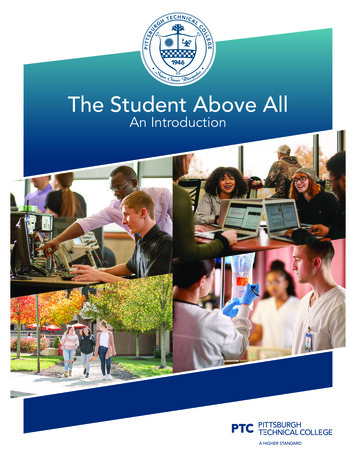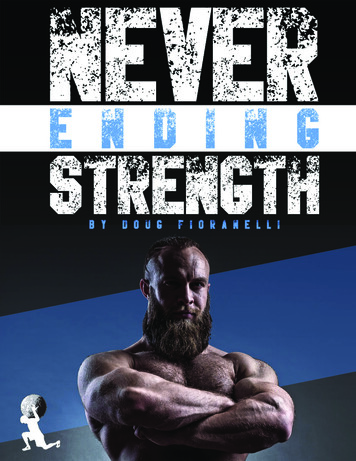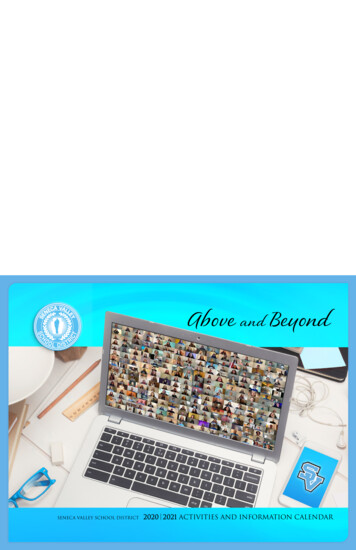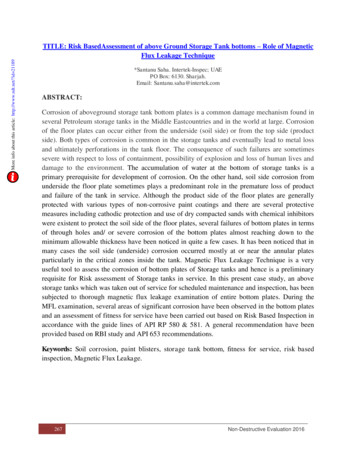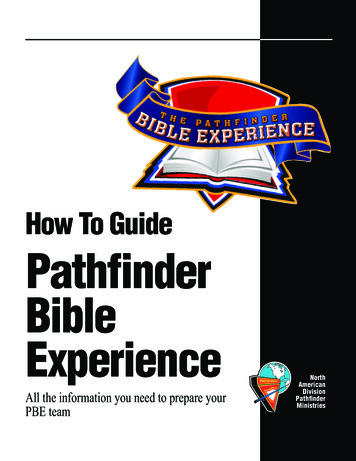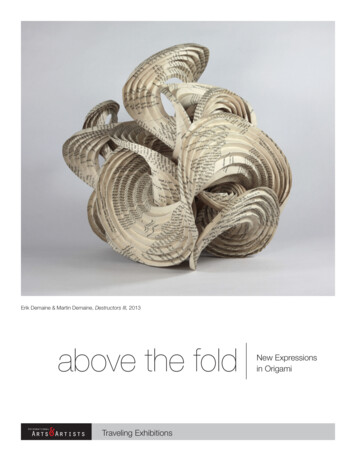
Transcription
Erik Demaine & Martin Demaine, Destructors III, 2013above the foldTraveling ExhibitionsNew Expressionsin Origami
above the foldNew Expressionsin OrigamiYuko Nishimura, Wave, 2013“To most, the real beauty oforigami lies in its simplicity,allowing everyone to createtheir interpretation of theworld in paper.”—VANESSA GOULD, director, Between the FoldsAbove the Fold demonstrates the extraordinary powerand potential of contemporary origami. In the handsof nine international artists, what was once considereda children’s craft becomes a sophisticated global art form.Paper is transformed into breathtaking sculpture, large-scaleinstallations and conceptual works that express contemporarysocial, political, aesthetic, and cultural dialogues. Above theFold is the first traveling exhibition to bring origami installationsfrom around the world to North American audiences.Visionary master folders—such as Erik Demaine andMartin Demaine (Canada/USA), Vincent Floderer (France),Miri Golan (Israel), Paul Jackson (UK/Israel), Dr. Robert J.Lang (USA), Yuko Nishimura (Japan), Richard Sweeney(UK), and Jiangmei Wu (China/USA)—push the boundariesof paper as a medium to create bold, provocative works.International Arts & Artists 9 Hillyer Court NW, Washington, DC 20008Phone 202.338.0680 Fax 202.333.0758 www.artsandartists.org 2
above the foldNew Expressionsin OrigamiPaul Jackson, Untitled, 2014Each artist will create pieces specifically for this tour—theircollective works have never been seen before anywhere inthe world.These nine internationally celebrated folders comprise a crosssection of contemporary origami artists, ranging in age from29 to 71, hailing from four different continents, and working inseven different countries. Their origami creations will presentoriginal, “above the fold” commentaries on diverse aspects ofmodern life and art.Origami, literally meaning “paper folding,” has evolved froma Japanese craft into a highly expressive, global art formthat intersects and impacts the realms of art and science.Today, artists from all over the world are folding paper into“Even DNA is folded—youand I are born from folding.”—PAUL JACKSON, Above the Fold artistincreasingly elaborate and provocative sculptural works,while scientists and mathematicians are using origami tounlock the mysteries of the universe. Since even our DNAis folded, origami artist Paul Jackson has expressed, “Youand I are born from folding.” We are all, in essence, worksof origami.International Arts & Artists 9 Hillyer Court NW, Washington, DC 20008Phone 202.338.0680 Fax 202.333.0758 www.artsandartists.org 3
above the foldNew Expressionsin OrigamiDetail of Vincent Floderer, Unidentified Flying Origami, 2002-2014The exhibition celebrates these artists who are redefining atraditional Japanese craft as a modern global genre, inventingunexpected forms of artistic expression.Their worksexemplify not only innovative methods of working with paper,but also the power of origami to unite disciplines as diverse assculpture and geometry, physics and religion, mathematicsand the global peace movement.Above the Fold was developed by International Arts & Artistsand independent curator, author, and educator MeherMcArthur, former curator of East Asian Art at Pacific AsiaMuseum in Pasadena, California and curator of the travelingexhibition, Folding Paper: The Infinite Possibilities of Origami.“This transformation offlat paper into swirlingsurfaces creates sculpturethat feels alive.”—ERIK DEMAINE, Above the Fold artistInternational Arts & Artists 9 Hillyer Court NW, Washington, DC 20008Phone 202.338.0680 Fax 202.333.0758 www.artsandartists.org 4
above the foldNew Expressionsin OrigamiRichard Sweeney, Air, 2014International Arts & Artists 9 Hillyer Court NW, Washington, DC 20008Phone 202.338.0680 Fax 202.333.0758 www.artsandartists.org 5
above the foldNew Expressionsin OrigamiDetail of Jiangmei Wu, Ruga Swan, 2014Jiangmei Wu works to illustrate how folding can be expressed mathmatically, physically, and asethetically,how it can be done with different materials and techniques, and how these aspects work together withthe conceptual space in which they occur. In her folded works like Ruga Swan (ruga is the Latin wordfo “a fold, crease, or wrinkle”), the folded forms have rigid properties and at the same time are flexible;they are deployable and can be collapsed again into smaller compressed forms. This installation, createdfrom two folded sections joined together, unites her fascination with interior skin, natural forms, andthe effects of light and shadow. There are many examples of folding-inspired design in architecture;however, folded architectural structures rarely make use of one of the main characteristic of folding design– the kinetic ability to morph from a two dimensional surface to a three-dimensional surface. Ruga Swanseeks to construct a deployable three dimensional semi-rigid structure that comes from fabricating twodimensional materials, that can be collapsed into, again, smaller compressed forms.International Arts & Artists 9 Hillyer Court NW, Washington, DC 20008Phone 202.338.0680 Fax 202.333.0758 www.artsandartists.org 6
above the foldNew Expressionsin OrigamiInstallation of Jiangmei Wu’s Ruga Swan (2014) at Springfield Museums, 2014Installation of Jiangmei Wu’s Ruga Swan (2014) at Springfield Museums, 2014International Arts & Artists 9 Hillyer Court NW, Washington, DC 20008Phone 202.338.0680 Fax 202.333.0758 www.artsandartists.org 7
above the foldNew Expressionsin OrigamiDetail of Robert Lang, Vertical Pond II, 2014About the CuratorMeher McArthur is a freelance Asian art curator, authorand educator, and curator of the traveling exhibition, FoldingPaper: The Infinite Possibilities of Origami. She received a BAin Japanese Studies from Cambridge University and a MA inJapanese art history from the School of Oriental and AfricanStudies (SOAS), London University. She worked for nineyears as Curator of East Asian Art at Pacific Asia Museum inPasadena, CA, where she curated 15 exhibitions, includingGods and Goblins: Japanese Folk Paintings from Otsu (1999),Constructing the Cosmos in the Religious Arts of Asia (2001),Paintings, Prints, and Drawings by Hokusai (2001), The Natureof the Beast: Portrayals of Animals in Japanese Paintings(2001), Visions of Enlightenment: Understanding the Art ofBuddhism (2002) and Kampai! The Arts of Japanese Sake(2004). She also curated the museum’s permanent ChineseCeramics Galleries (2000) and Gallery of Japanese Art (2006).As a guest curator at Pacific Asia Museum, she curated Jade,Silk, Porcelain : An Introduction to the Materials of AsianArt (2007), The Religious Arts of Japan (2007), Lotus Moon:The Arts of Otagaki Rengetsu (2008), Confucius: ShapingValues Through Art (2008-9), and Japan in Blue and White(March 2010-March 2011). She lectures and advises at severalmuseums in Southern California, including the Santa BarbaraMuseum of Art, the Huntington Library, Art Collections, andBotanical Gardens, and the Bowers Museum of Cultural Artin Santa Ana, and has advised on Buddhist Art installationsfor the Victoria and Albert Museum in London. She is also avisiting professor at Scripps College in Claremont, California.Her publications include Gods and Goblins: Japanese FolkPaintings from Otsu (Pacific Asia Museum, 1999), ReadingBuddhist Art: An Illustrated Guide to Buddhist Signs andSymbols (Thames & Hudson, 2002), The Arts of Asia: Materials,Techniques, Styles (Thames & Hudson, 2005), Confucius(Quercus, London, 2010), published in the USA as Confucius:A Throneless King (Pegasus Books, 2011), and Folding Paper:The Infinite Possibilities of Origami (International Arts & Artists,2012). She has also published two children’s books about art:Michael and the Magical Museum (Pacific Asia Museum, 2003)and An ABC of What Art Can Be (The Getty Museum, 2010).International Arts & Artists 9 Hillyer Court NW, Washington, DC 20008Phone 202.338.0680 Fax 202.333.0758 www.artsandartists.org 8
above the foldNew Expressionsin OrigamiDetail of Erik Demaine and Martin Demaine, Greene Recycling/Destructors VIII, 2013Miri Golan, Twisted Holy Book, 2014ArtistsErik Demaine and Martin Demaine (Canada/USA)A father-son collaborative team, the Demaines fold, pleat, andtwist paper into powerful sculptural forms that illustrate theintriguing and profound connections between mathematicsand origami. They use mathematical calculations to createunconventional works that challenge the direction of paperfoldling. For years, the Demaines have been exploring thepotential of curved folding, in which paper is folded along acurved, rather than a straight line. The Demaines plan to fold aseries of their signature, abstract “Curved-Crease Sculptures”using modular techniques to increase sculptural size. Theywill also create combined glass-and-paper folded forms,large works that incorporate text, and mobius hypars (curvedcrease foldings) interlocked through space, thus blending art,science and literature.Vincent Floderer (France)An artist who specializes in crumpling, a technique that includesdampening and stretching origami paper to create organicand multi-layered forms, Floderer will create a dynamic, largescale installation called Unidentified Flying Origami. It will bea universe of floating, rotating organic models that move viaair flow. The models will show the creative process Flodereruses to develop his crumpling techniques. Each model derivesfrom classical, modular, box-pleated origami forms that hetransforms into otherworldly creations. The installation willadapt to each venue’s gallery space, changing aestheticallywith each presentation.Miri Golan (Israel)A peace activist, educator, and origami artist, Golan will createa series of book sculptures, based on her conceptual FoldingPaper piece, Two Books, in which origami figures emerge fromthe pages of two sacred texts, the Torah and the Koran, andreach out to each other. Golan hopes to use her installationsas a catalyst to unite people of different religious and culturalbackgrounds. She has founded an organization called FoldingTogether, a group that encourages Israeli and Palestinianchildren and adults to fold paper forms as a team, turning thecreation of origami into a collaborative expression of hope fora more peaceful world. Golan’s work represents the possibilityfor origami to be not only a means of artistic expression, butalso a platform for positive social change.International Arts & Artists 9 Hillyer Court NW, Washington, DC 20008Phone 202.338.0680 Fax 202.333.0758 www.artsandartists.org 9
above the foldNew Expressionsin OrigamiPaul Jackson (UK/Israel)A folder who specializes in abstract origami sculptures,Jackson will design a series of large, folded photographsfeaturing the artist’s own hands. The piece, Untitled, will besuspended from the ceiling, with images appearing on thefront and back of the sculpture. On one side the image willappear smooth, and on the opposite it will be fragmentedor abstracted, offering new perspectives on how we viewourselves.Dr. Robert J. Lang (USA)A former NASA Jet Propulsion Laboratory laser physicistand professional origami artist, author and lecturer, Dr. Langwill create a large, modular mathematical piece exploringthe concept of infinity. In modular origami, multiple sheetsof paper are folded into individual units—or modules—andcombined to form larger, more complex geometric structures.Works are held together by the friction and tension created byinserting flaps from one module into pockets of another. TitledPentasia, the surface of Dr. Lang’s work will be composedof equilateral triangles and theoretically extends to infinitywithout ever repeating itself.Richard Sweeney (UK)A multi-media artist, Sweeney combines handcrafted, threedimensional models with computer-aided design and CNC(computer numerical control) techniques in the creation of hisworks. He will create a pleated paper installation called Airthat spirals downward from the ceiling in a form that blendspoetry with precision.Jiangmei Wu (China/USA)An Assistant Professor of design at Indiana University, Bloomington, where she does interdisciplinary work in art, design,mathmatics, science, and engineering. In addition to practicing and teaching art and design, Wu has consistently been interested as in design as it affects the public realm, historicallyand culturally, and most importantly, from the perspective ofsustainable design and development. Recently, she has beeninvestigating the relationship between geometry, surface texture, computational algorithms, and making techniques in theart and science of paper folding. Her recent works, including Ruga Swan, have been made using eco-friendly materialsand techniques, for which she has gained international recognition and has been published world-wide.Yuko Nishimura (Japan)A young talent, Nishimura is already an award-winningorigami artist. With a background in architecture anddesign, Nishimura will contribute several framed, wall-hungtessellations. Nishimura comments, “Japanese peopleunconsciously experience the action of folding on a dailybasis, and therefore encounter various folded forms. I thinkthere must be a special meaning for Japanese people throughthis everyday practice, folding .In order to link the past withfuture generations regarding the form of folding, I do not limitmyself to the category of origami but consider the pursuit ofany possibility of folding paper.” Erik Demaine & Martin Demaine,Greene Recycling/Destructors VII, 2013International Arts & Artists 9 Hillyer Court NW, Washington, DC 20008Phone 202.338.0680 Fax 202.333.0758 www.artsandartists.org 10
above the foldNew Expressionsin OrigamiDetail of Yuko Nishmura, Shine, 2008SpecificationsNumber of WorksApproximately 15 conceptual works and installationsParticipation Fee 35,000 plus courier travel costsRequirementsModerate security; 4,
Origami, literally meaning “paper folding,” has evolved from a Japanese craft into a highly expressive, global art form that intersects and impacts the realms of art and science. Today, artists from all over the world are folding paper into “Even DNA is folded—you and I are born from folding.” —PAUL JACKSON, Above the Fold artist Paul Jackson, Untitled, 2014 increasingly elaborate .
